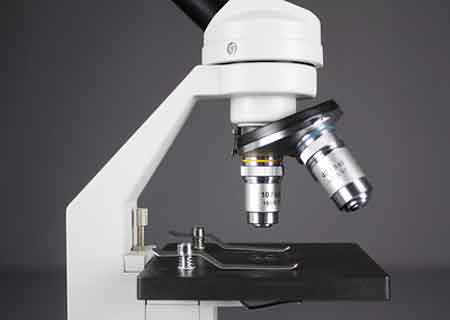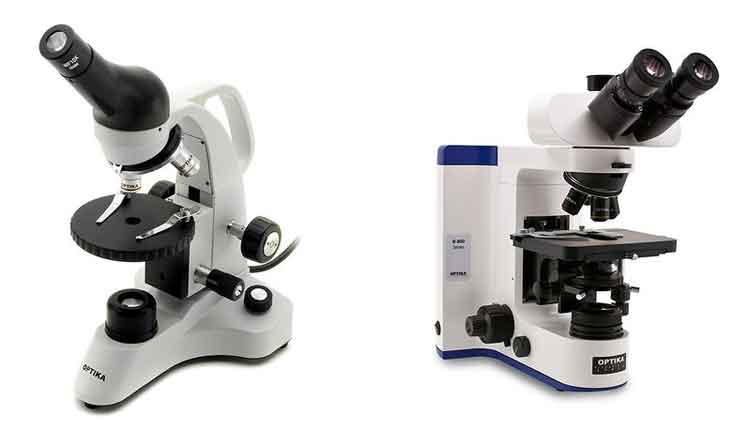The monocular microscope is a familiar sight in many older laboratories, as well as in many basic, usually elementary biology textbooks. The monocular microscope has its own advantages and disadvantages. Because a prism is required to bring the light from the objective lenses to the eyepiece, designing a prism to bring the light to a single eyepiece is easier than designing an entire prism system to bring the light to two eyepieces, as is the case in binocular microscopes. This confers and added advantage to monocular microscopes: they are relatively cheaper than most microscopes now available on the market.
On the other hand, monocular microscopes can be difficult to use. The extremely old versions of the monocular microscope had only a mirror to help reflect light from an external source onto the specimen being viewed. This was difficult to do if the monocular microscope had to be brought out onto the field, and if field work had to be done in low lighting conditions, at night, or in shadow. Focused light could also damage specimens, and could focus heat onto a specimen, scorching it or changing its appearance.

Another great disadvantage of monocular microscopes is the fact that users can use only one eye when looking through them. This can be very straining for many researchers who have to spend the entire day looking through a microscope. The key to surviving in a laboratory using a monocular microscope is to keep both eyes open, but to focus only one eye as it peers through the eyepiece objective lens of the monocular microscope. This can take some getting used to, but as most researchers will attest, it can save one’s eyes from strain (not to mention one’s forehead and temples from premature wrinkles).
Today’s monocular microscopes, however, have new advantages literally plugged into them, so that users will no longer have to worry about eyestrain or lack of illumination. For one, digital monocular microscopes offer the added advantage of easy and on-the-spot documentation. Digital monocular microscopes allow users to take pictures of their specimens, or to take videos of them, using an attached digital camera that is mounted onto the monocular microscope’s eyepieces, or is built into the monocular microscope’s body.
Because the digital camera shares lenses with the eyepiece of the monocular microscope, extreme care should be exercised when handling the eyepiece objectives. They should always be cleaned and kept free from dust and grime. The same should be carried out with the objective lenses, since it is their clarity and quality that determine the clarity and quality of the images that will be produced.
Another development in monocular microscopes is the cordless monocular microscope. Because many of today’s monocular microscopes are already digital, they need an external energy or electricity source in order to operate the light source and the digital camera. However, this is impossible if a researcher needs to use the camera out in the field, where no electric sockets are available. The situation can be even more difficult in low lighting conditions or bad weather, or in any other external environmental influence that a researcher will have to face.
Cordless monocular microscopes offer the advantage of using batteries to power the digital camera and the light source. This can be advantageous in the field, or even in a laboratory that is practicing energy saving techniques to lower energy costs in the laboratory. Other cordless monocular microscopes rely on external light sources, which can come in the form of a halogen bulb or a bright flashlight in the field. This can be advantageous for scientists who want to work with a particular light source shining a beam of light at a particular angle on a specimen.
A cordless monocular microscope can be advantageous to a lab that is already full of wires and cords, increasing the risk of researchers tripping over wires and destroying expensive equipment. It can still be disadvantageous, however, if the digital camera is used often, since this requires that researchers replace batteries immediately. Nevertheless, there are some cordless monocular microscopes that have rechargeable batteries, so if researchers have some access to electricity to charge the battery, then they can still use the microscope for some time.
The website emailmeform.com/builder/emf/produkt/starscope-monocular-test can provide you with even more information on how you can make the best use of your cordless monocular microscope, as well as how you can buy other kinds of digital monocular microscopes that can meet your laboratory or classroom needs. If you can balance budget with research needs, and if you can find the best monocular microscopes to meet both these needs, then you will be able to get better research findings.











 How to Install a Garage Door Opener
How to Install a Garage Door Opener